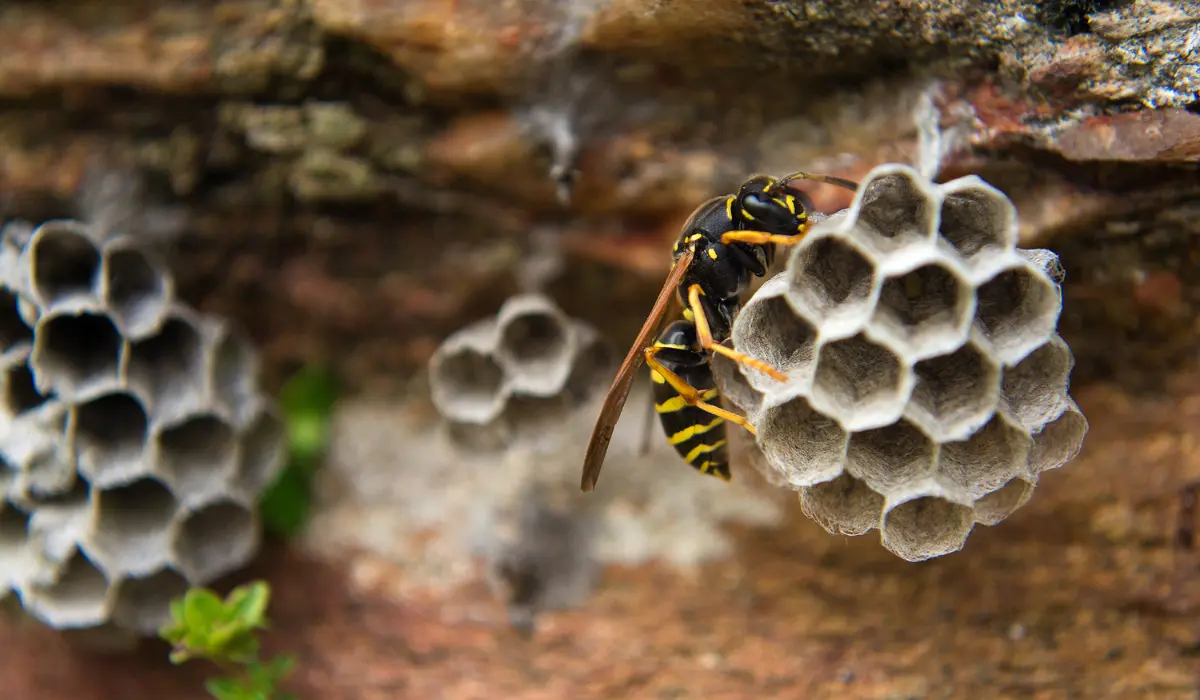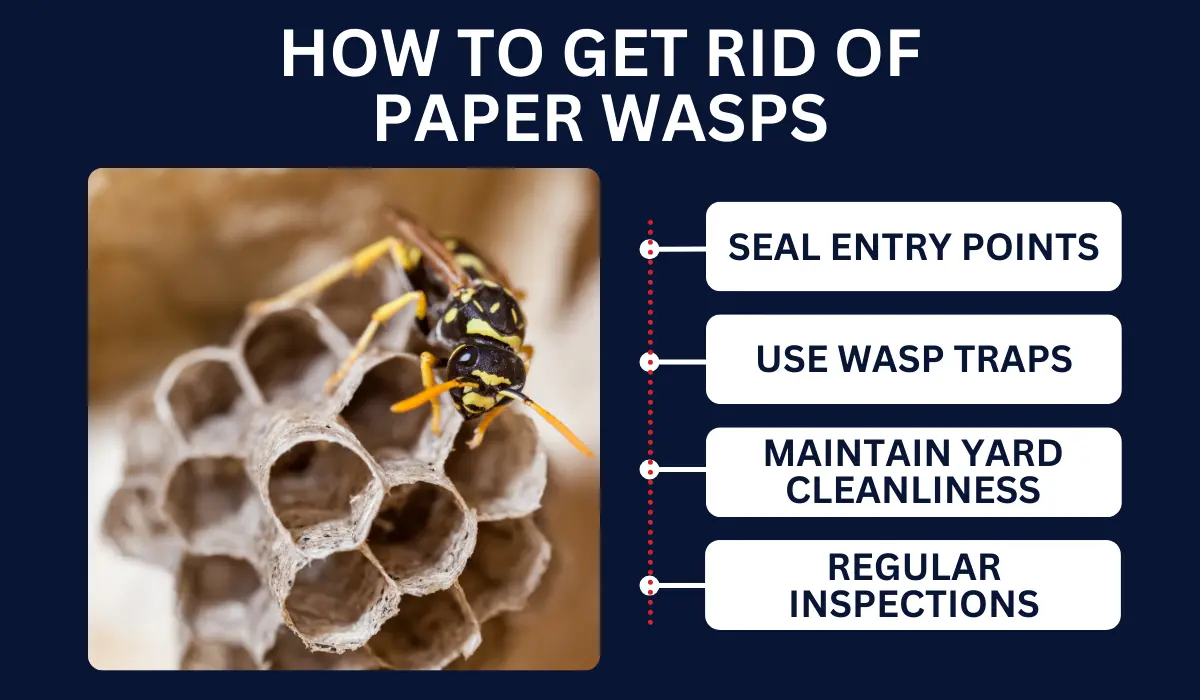
If you’ve ever spent time outdoors in Louisiana, you’ve likely come across paper wasps. These stinging insects are both fascinating and a bit unnerving due to their tendency to build nests around homes and gardens.
What steps can you take to deal with paper wasps if they become a nuisance safely? Keep reading to learn the intriguing world of paper wasps.
Key Takeaways
- Paper wasps benefit ecosystems by controlling pests and pollinating plants, but can be hazardous due to their stings and allergenic potential.
- They are recognized by their long, slender bodies, black wings with yellow markings, and prominent antennae, which are essential for navigation.
- Paper wasp nests are made of chewed wood and saliva and are commonly found in sheltered spots like eaves and tree branches.
- Effective wasp management includes sealing entry points, using traps, keeping yards clean, and opting for professional pest control for severe infestations.
WHAT ARE PAPER WASPS?
Paper wasps are known for their distinctive nests and social behavior. These insects have unique physical characteristics and specific nesting habits.
Physical Characteristics
Paper wasps, part of the Hymenoptera order in the Vespidae family, showcase unique features that set them apart from other wasp species.
You can usually identify them by these features:
| Physical Aspects | Details |
|---|---|
| Body Shape | Long and slender |
| Color | Black wings with yellow markings |
| Length | Approximately 1-1.5 inches |
| Antennae | Prominent and essential for navigation |
| Stinger | Present, used defensively |
Nesting Habits and Behavior
Paper wasps are social insects that build open-comb nests. Their nest construction and maintenance involve:
| Nesting Aspects | Description |
|---|---|
| Material | Chewed wood fibers combined with saliva |
| Shape | Open cells in a comb-like structure |
| Location | Eaves, attics, and other sheltered places |
| Season Activity | Construct nests mainly in late summer and early fall |
| Colony Structure | Consists of a queen and worker wasps |
THE BENEFITS AND DANGERS OF PAPER WASPS
Benefits
Paper wasps play a valuable role in natural ecosystems. Here are their several benefits:
- They feed on insect pests like caterpillars, which help farmers and gardeners.
- Although not as effective as bees, they contribute to pollination.
- Their activities support various plant species and other insects.
- By preying on pests, they maintain the balance of different ecosystem species.
Dangers
Despite their benefits, paper wasps can threaten humans due to their defensive nature. The following dangers highlight their risks:
- Their painful stings can cause allergic reactions.
- They become aggressive when their nests are disturbed.
- They can feed on resident species and invade their natural habitat.
- They often nest near residences, leading to more frequent human interactions.
- They compete for resources, affecting the honey bee population negatively.
HOW TO IDENTIFY A PAPER WASP NEST
Paper wasp nests have a distinctive look, making them easier to identify if you know what to look for.
These nests are usually grayish, resembling paper-like material. They have an open, umbrella-like shape, often described as looking like an upside-down umbrella.
One critical feature of the nest is the visible hexagonal cells. Unlike European hornet nests, their nests are not covered with an outer layer.
Housing eggs, larvae, and adults, paper wasp nests are often built in sheltered spots that shield them from the weather. These locations are often near or around:
- Eaves: Shelter and easy access to nearby gardens
- Crevices: Protection from predators and elements
- Tree Branches: Convenient for foraging and building
HOW TO GET RID OF PAPER WASPS

To maintain a pest-free environment and prevent future paper wasp infestations, consider these steps as homeowners:
- Seal Entry Points: Check and seal cracks in walls or around windows where wasps might enter.
- Use Wasp Traps: Hang commercial traps around the yard to catch wasps before they build nests.
- Maintain Yard Cleanliness: Keep food and garbage bins tightly sealed to remove attractants like sweet and sticky substances.
- Regular Inspections: Inspect your property frequently during the warmer months to catch nests early before they become a problem.
PROFESSIONAL PEST CONTROL SOLUTIONS
Professional pest control offers comprehensive services to manage paper wasps in Louisiana. At LaJaunie’s Pest Control, our pest technician provides a strategic approach to tackle your wasp problems.
Here are the typical steps when addressing the problem:
| Services | Details |
|---|---|
| Identification | Free phone consultation to identify whether the pest is a type of wasp. |
| Initial Visit | Visit to take control of the situation and verify the pest’s identity. |
| Treatment | Covering eaves up to 25 feet and areas around grass and foliage with products like Waspfreeze or Bifen. |
| Follow-up Visit | Additional visits may be required for pests like mud daubers, yellowjackets, cicada killers, and bald-faced hornets that may take over and need removal. |
IS IT TIME TO CALL A PROFESSIONAL?
If there’s a high risk for wasp stings or their nests are inside walls and high places, it’s best to call pest control professionals.
Whether you’re in Baton Rouge or New Orleans, seeking expert help should be easy. For immediate intervention for a severe infestation, let Lajaunie’s wasp & hornet control specialists tailor a solution that’s right for your home.
For more information about the areas we service, visit our location page.